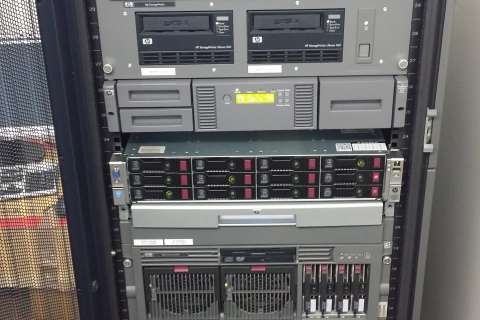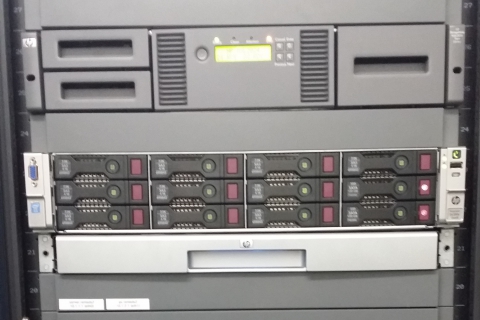In September 2014, I travelled up to Cairns to complete installation & UAT/signoff of a major system upgrade for Fugro’s Navy client, the Royal Australian Navy LADS Flight unit.
This was the second major upgrade to the Navy’s system in my time with Fugro. When I first began supporting the Navy system in 2007, they were still using the original system that Fugro LADS (then Vision Systems) designed for them in 1993. This original system was based on two MIPS RISC/OS servers & Sun workstations. In 2008 the software was ported to Linux, and the MIPS & Sun machines were replaced with HP Proliant servers & workstations running Red Hat Enterprise Linux 4.
The 2014 update was also a system-wide upgrade which included a new airborne system, new ground system server & major software enhancements, a new portable server system & laptops for deployment, plus hardware & OS upgrades on 12 workstations.
I only have two usable photos of the 2014 main server upgrade. The first is a pic taken during UAT with the old server AND new server both in the rack at the same time:
The old server was a HP DL380 with two MSA disk shelves, two LTO3 tape drives, and a dual-drive LTO3 tape library. This was replaced by a more compact HP server, running RHEL 6, and with enough internal storage that separate disk shelves were no longer needed. In addition to the new server installed in Cairns at the client site, an identically-specced development server was already installed in our Adelaide office.
The upgrade to the airborne LIDAR system also meant the two LTO3 tape drives were no longer needed to transfer data from the plane, with USB devices being used instead of tape. The tape library was upgraded from older LTO3 to a newer library with LTO5 drives for backup purposes.
The photo below was taken after the client accepted the system. With the old system removed, there was a lot of room in the rack, leaving the new server looking a bit lonely:
We also upgraded all the workstations, and the portable ground system (PGS). The PGS is a HP server, housed in a custom built portable rack which goes into the field. The rack is built like a small tank – allowing the PGS to be moved around on wheels, and the rack itelf was unchanged in the upgrade. Only the server & components in the PGS rack were upgraded.
I don’t have any photos of the upgraded PGS, but I do have some photos of the old PGS, including one where you can see a black metal frame up against the wall. This frame allows the PGS to be bolted down and transported on the Navy’s Dash-8 aircraft, for deployment around Australia and occasionally overseas, eg to Mackay (QLD), Hobart (Tas), Christmas Island, and Papua New Guinea:

